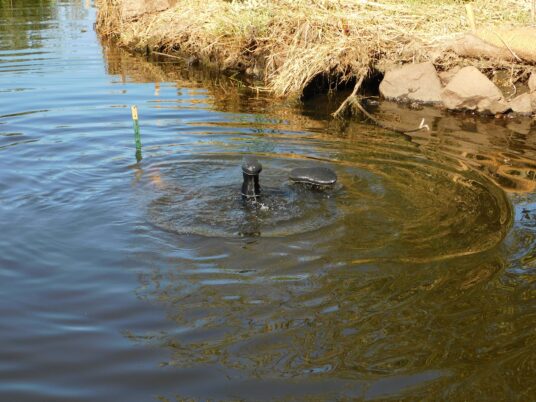The Army Corps of Beavineers
Or, how building dams isn’t a beaver’s best trick.

by Marcia Wilson
Follow-up from earlier article here.
“The ways that beavers interact with their habitat are varied, incredible, and teeth-dependent. Their dam- and lodge-building are regular feats of engineering; their ability to alter ecosystems to suit their needs is second only to humans; and their diet is based on a food source with notoriously inaccessible nutrients: beavers tackle all of these with apparent ease, and big buck teeth”.—from Wood You Eat That? by Michael Allen Bryden
Twice trees and second lunches
Their favorite food is the water lily. They like to roll up a juicy pad and eat it like a hot dog or enchilada. Soft plants are less work for their impressive digestion systems but not a reliable source of year-round nutrition. Thus, beavers harvest trees for edible bark. The ‘edible’ is a broad word. Bark keeps all winter but is hard to chew and digest.
When a beaver chews up a meal it passes through a specialized intestinal pouch called the cecum. The cecum holds enzymes that speed up digestive fermentation and break up the fibers. Once this meal passes through the system, it is a coecotrophe—a half-digested slurry of fermenting plant matter. The beaver then eats it again. This is coprophagy, the practice of eating one’s feces. When the beaver excretes for the last time, the feces are dry and odorless balls of sawdust.
It sounds terrible, but if these animals don’t maximize their meal, they die. Many mammals, mostly lagomorphs, are coprophages for similar reasons.
Beavers are teachers
Beavers will not mindlessly cut down all trees for a meal or lodge-building; they often avoid evergreens, disliking the resin or any trees with an unpleasant mouthfeel. Observing this, humans ring trees with sand-filled paint to keep them from chewing on selected trees. Even the smell of paint may be enough to briefly deter them:
“Beavers can’t see well. Their primary sense is smell. A beaver uses its nose to locate the cinnamon smell of birch and the licorice tang of aspen.”—by L.A. Philip, Beaverland: How One Weird Rodent Made America,
All of this is to explain that beavers will not easily give up their habits. They will not ask humans which trees they can harvest. They must be tireless in their efforts to shape their watery world to their advantage. Happily, when there is no species/territory competition, beaver and human have a great relationship.
We are still learning from them.

Human Beavineers and beaver dam analogs
What did you say?
“A beaver dam analogue is a habitat management tool that mimics a naturally occurring beaver dam. It is simple, small and is often installed in series.”—workingwithbeavers.ca
In the absence of beavers, we must pretend to be beavers. To that end, various governments across the world are emulating their dam-building models to expand wetlands with minimum negative impact. It isn’t the same as having the real animal on the team, but it helps.
Beaver dams increase the biodiversity of their habituated wetlands. There are several factors in this ecological shift, but here are some core reasons:
- Beaver dams slow the water flow, reducing loss of soil and vegetation by flooding and silt wash.
- They build canals that link pools and ponds, increasing the potential of food for prey and predators.

Photo Marcia Wilson. City of Tacoma’s Chris Burke (left) and Dr. Faust (right) are setting temperature sensors in the college wetlands. The batteries will last for months, providing real-time data for watershed management.
They keep these canals “clean” by scraping mud and silt deposits. These canals help them float lengths of wood that weigh as much as 100 lbs! Beaver canals may do as much or more for the health of a wetlands than their dams. - Beavers work collaboratively to control water flow. Adults cooperate in rolling boulders, towing heavy logs, and packing mud into leaking dams. They can control the direction their trees fall at a ratio of 7:10.
- A note of caution: if observing them while cutting trees, remember the words of photographer Alexander V. Badyaev: “I have completely entrusted my life to the mind and engineering skills of a rodent.”
- Beaver-supported ecosystems are highly resistant to the damage wrecked by wildfires; their work lifts the water table and increases the surface area of water-to-surface percentage.
The First Wildlife Corridors were made by beavers
- Beaver dams are “wildlife corridors” used by other species to hunt or seek shelter. Dams are traversed by otter, mink, coyote, fox, raccoons and small rodents like the vole and rat.
- Below and around dams the CPTC volunteers have reported higher levels of activity for a broad range of wildlife. Catfish lurk in the deeper pools, unthreatened by the vegetarian beavers, but hunted by many other species.
- Beaver dams support fish habitats. The City of Tacoma has taken multiple floats down the Flett marsh with Dr. Faust and his students, testing the water temperature with special probes. They have learned that the water downstream of the dams is cooler by a few degrees. These few degrees can be crucial during extreme heat waves and droughts. As a spokesman for Trout Unlimited explained to the author, it takes a concrete wall or forested corridor to make a three-degree temperature drop per mile in a typical river. That is, assuming it is possible to build a wall or corridor. When beaver dams are not interfering with human waterways, they provide a low-cost option for keeping cool.
- Humans are learning how to live with beavers profitably. And this may be the sticking point. Every year when schedules agree, the City of Tacoma and CPTC collaborates with a float down the Flett Marsh to investigate its conditions. The Flett marshes are a major source of drinking water for Tacoma, their natural filtration system saving South Puget Sound millions of dollars in water treatment. Beavers are a vital component of its health.
